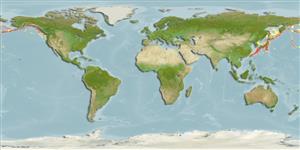Common names from other countries
Environment: milieu / climate zone / depth range / distribution range
Ecologia
marinhas bentopelágico; intervalo de profundidade 612 - 1700 m (Ref. 50550). Temperate; 66°N -
North Pacific: Pusan, Korea north (outside the Sea of Okhotsk) to Providence Bay in the Anadyr Gulf of the Bering Sea, throughout the Aleutian Basin and islands, and southeast to Mathieson Channel, British Columbia, Canada.
Tamanho / Peso / Idade
Maturity: Lm ? range ? - ? cm
Max length : 41.0 cm TL macho/indeterminado; (Ref. 56527); peso máx. publicado: 2.3 kg (Ref. 56527)
Descrição suscinta
Chaves de identificação | Morfologia | Morfometria
Espinhos dorsais (total) : 0; Raios dorsais (total) : 8 - 9; Espinhos anais: 0; Raios anais : 7 - 9. Brownish gray with dark spots dorsally, muddy gray ventrally. Caudal fin rounded; pectoral fins large and broadly based; pelvic fins modified to form a clinging disc with a thickened margin on the ventral surface of the body (Ref. 6885). Skin naked without scales and tubercles. First dorsal fin completely embedded under the skin. Disk rudimentary in young, well developed in adults (Ref. 43939).
Males are said to guard the eggs (Ref. 6885). Migrate to spawn in littoral waters of Bering Sea in December-June (Ref. 43939).
Ciclo de vida ou comportamento de acasalamento
Maturities | Reprodução | Spawnings | Egg(s) | Fecundities | Larvas
Eschmeyer, W.N., E.S. Herald and H. Hammann, 1983. A field guide to Pacific coast fishes of North America. Boston (MA, USA): Houghton Mifflin Company. xii+336 p. (Ref. 2850)
Status na Lista Vermelha da UICN (Ref. 130435)
CITES (Ref. 128078)
Not Evaluated
Ameaça para os humanos
Harmless
Uso pelos humanos
Ferramentas
Relatórios especiais
Baixar XML
Fontes da internet
Estimates based on models
Preferred temperature (Ref.
115969): 2.3 - 4.6, mean 2.8 (based on 159 cells).
Índice de diversidade filogenética (Ref.
82804): PD
50 = 1.0000 [Uniqueness, from 0.5 = low to 2.0 = high].
Bayesian length-weight: a=0.01995 (0.00906 - 0.04395), b=3.01 (2.83 - 3.19), in cm Total Length, based on all LWR estimates for this body shape (Ref.
93245).
Nível Trófico (Ref.
69278): 3.7 ±0.38 se; based on food items.
Resiliência (Ref.
120179): médio(a), tempo mínimo de duplicação da população 1,4 - 4,4 anos (Preliminary K or Fecundity.).
Fishing Vulnerability (Ref.
59153): Low to moderate vulnerability (31 of 100).
